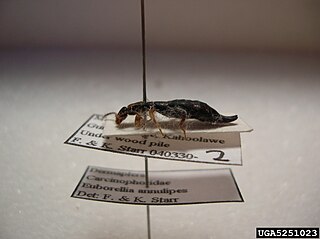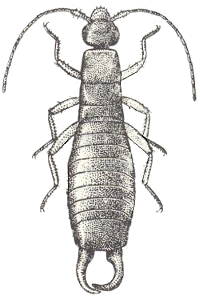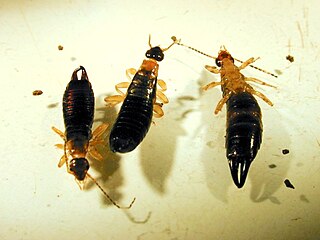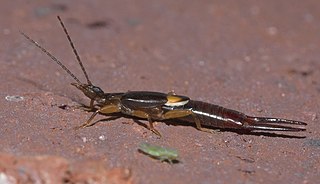
Earwigs make up the insect order Dermaptera. With about 2,000 species in 12 families, they are one of the smaller insect orders. Earwigs have characteristic cerci, a pair of forcep-like pincers on their abdomen, and membranous wings folded underneath short, rarely used forewings, hence the scientific order name, "skin wings". Some groups are tiny parasites on mammals and lack the typical pincers. Earwigs are found on all continents except Antarctica.

Pygidicranidae is a family of earwigs in the suborder Neodermaptera. The family currently contains twelve subfamilies and twenty six genera. Eight of the subfamilies are monotypic, each containing a single genus. Of the subfamilies, both Astreptolabidinae and Burmapygiinae are extinct and known solely from fossils found in Burmese amber. Similarly Archaeosoma, Gallinympha, and Geosoma, which have not been placed into any of the subfamilies, are also known only from fossils. Living members of the family are found in Australia, South Africa, North America, and Asia. The monotypic genus Anataelia, described by Ignacio Bolivar in 1899, is found only on the Canary Islands. As with all members of Neodermaptera, pygidicranids do not have any ocelli. The typical pygidicranid bodyplan includes a small, flattened-looking body, which has a dense covering of bristly hairs (setae). The pair of cerci at the end of the abdomen are symmetrical in structure. The head is broad, with the fourth, fifth and sixth antenna segments (antennomeres) that are not transverse. In general Pygidicranids also have equally sized ventral cervical sclerites, and in having the rearmost sclerite separated from, or only touching the center of the prosternum. Cannibalism of young has been observed in at least one species in the family, Challia hongkongensis, in which an adult female was found eating a still-living nymph of the same species. The same species in a different area has been observed possibly eating fruits or seeds, making the species an omnivore.

Anisolabididae is a family of earwigs, in the suborder Neodermaptera and the order Dermaptera.

Anisolabis is a genus of mostly Asian earwigs in the subfamily Anisolabidinae. It was cited by Srivastava in Part 2 of Fauna of India. The name Anisolabis stems from the asymmetry of the male cerci; the right cercus being more acute than the left.

Euborellia is a genus of earwigs in the subfamily Anisolabidinae. This genus, which has a world-wide distribution, was erected by Malcolm Burr in 1909 and was cited by Srivastava in Part 2 of Fauna of India.

Chelisochidae is a family of earwigs whose members are commonly known as black earwigs. The family contains a total of approximately 96 species, spread across sixteen genera in three subfamilies.
Euborellia plebeja is a species of earwig in the family Anisolabididae. Like other members of the Anisolabididae family, this species has an elongated virga, a sclerotized tube that is part of the male genitalia.
Anisolabis breviforceps is a species of earwig in the genus Anisolabis, the family Anisolabididae, and the order Dermaptera. It was first classified in 1979 by Brindle.
Anisolabis hawaiiensis is a species of earwig in the genus Anisolabis, the family Anisolabididae, and the order Dermaptera. The species is native to Hawaii, and was first classified by Brindle in 1979.

The seashore earwig is a species of earwig in the family Anisolabididae. The species was first described in 1846 by Adam White. This species has a blackish-brown body with brown-yellow legs. It has two light brown spots on its head, close to the inside of each eye. Its abdomen is widest at the seventh segment. It is flightless. It is native to eastern Australia and New Zealand. Similar both ecologically and taxonomically to the maritime earwig, this species is commonly found on beaches under stones and debris. It is a carnivore, feeding on millipedes, flies, and isopods such as woodlice. Like most other earwigs, the females care for their young during development, and the larva go through five instars before becoming adults. The species also has a negative phototaxis, meaning that it tends to move away from a light source.
Anisolabis mauiensis is a species of earwig in the genus Anisolabis, the family Anisolabididae, and the order Dermaptera.
Anisolabis oahuensis is a species of earwig in the genus Anisolabis, the family Anisolabididae, and the order Dermaptera.
The Pacific earwig is a species of earwig in the genus Anisolabis, the family Anisolabididae and the order Dermaptera.

Labia minor, the lesser earwig or small earwig, is a species of earwig. It is widespread globally in temperate climates, preferring warm locations such as compost heaps in parts of its range. It is 4–7 mm long, including the pincer, and chocolate brown in color.

Vostox is a genus of earwigs in the family Spongiphoridae, found in the Americas. There are more than 20 described species in Vostox.

Marava is a genus of earwigs in the family Spongiphoridae; most records are from the Americas, but M. arachidis is cosmopolitan. There are more than 50 described species in Marava.

Guanchia is a genus of earwigs in the family Forficulidae. There are more than 30 described species in Guanchia.
Haplodiplatys is a genus of Asian earwigs erected by Walter Douglas Hincks in 1955. It is the only member of the monotypic family Haplodiplatyidae, with many species originally placed in the genus Diplatys; a key to them was prepared by Alan Brindle.










